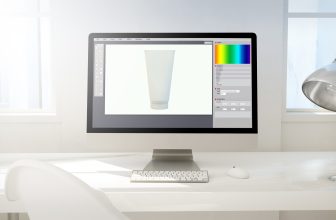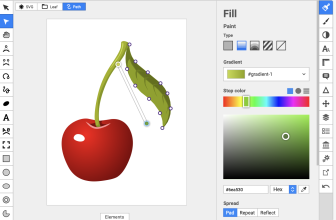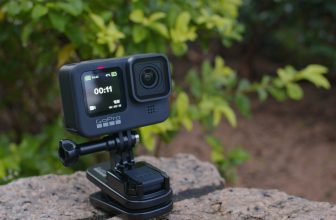A UX design course is a structured program that teaches the principles, techniques, and methodologies used in user experience (UX) design. These courses are for individuals who want to create intuitive and user-friendly interfaces for digital products, such as websites, apps, and software.
By enrolling in a UX design course, students will learn essential skills such as user research, information architecture, interaction design, and visual design.

What is the difference between UI and UX Design?
User Interface (UI) design and User Experience (UX) design are two distinct yet closely related disciplines in the digital product development process. UI design focuses on the visual aspects of a product, including layout, color schemes, typography, and graphics. On the other hand, UX design is concerned with the overall experience that users have when interacting with a product.
This involves understanding user needs and preferences, creating seamless interactions, and ensuring that the product is easy to use and enjoyable.
What we cover
What Skills Should a UX Design Course Teach You?
A high-quality UX design course should cover foundational skills that are essential for aspiring UX designers. Some key skills that a good UX design course will teach include:
- UX Research: Understanding user needs and preferences through interviews, surveys, and observational methods. UX research forms the backbone of UX design. It involves understanding the user’s needs, motivations, and behaviors, which is critical to designing products that meet user expectations.
- Design Tools: Gaining proficiency in industry-standard design tools like Sketch, Figma, and Adobe XD. These tools allow designers to create wireframes, prototypes, and high-fidelity designs. Mastery of these tools is crucial for transforming user needs and business goals into tangible design solutions.
- Career Prep: Building a UX design career requires more than technical skills. A comprehensive UX design course should also cover aspects like building a compelling portfolio that showcases your design process and outcomes, networking with industry professionals, and mastering job search and interview strategies.
- User Interface (UI) Design: While UX and UI are distinct fields, they are closely related. UX designers need to understand the basics of UI design, as it’s the UI that implements the UX designs. This includes creating visually engaging and interactive designs that facilitate a positive user experience.
- Information Architecture (IA): This involves organizing and structuring information in a clear, understandable way. It’s a crucial skill for UX designers, as it helps them design intuitive navigation and create coherent, user-friendly interfaces.
- Interaction Design: Interaction design is about creating meaningful relationships between people and the products they use, from apps to websites and everything in between. UX designers need to understand how users interact with products, including the many interfaces and systems involved in that interaction.
Recommendations Table
| Course Name | Provider | Price | Duration | Area of Focus | Our View |
| UX Academy | DesignLab | $ $6,900 (or $499/month with deferred tuition) | 15-30 weeks | Full UX design process | Best Overall |
| Springboard UX Design Bootcamp | Springboard | $8,500 (or $1,299/month with deferred tuition) | 6 months | Full UX design process | Best Paid |
| Google UX Design Professional Certificate | Coursera | Free (with $39 subscription to Coursera) | 3-6 months | UX research, prototyping, and testing | Best Free |
| UX Design Short Course | CareerFoundry | Free | 1 week | Full UX design process | Best for Beginners |
| User Experience (UX): The Ultimate Guide to Usability and UX | Udemy | $3,790 (or $599 with discount) | 12 hours | UX research, prototyping, and testing | Highest Rated |
Best Free UX Design Courses
1) Google UX Design Professional Certificate (Coursera)
An affordable, self-paced UX design course by Google that provides a solid foundation for beginners but with a Google-centric perspective.
- Price: Free (with $39 subscription to Coursera)
- Duration: Self-paced, typically completed in 3 to 6 months with about 10 hours of study per week
- Ideal For: Beginners seeking to break into the UX design field
- Website: Google UX Design Professional Certificate
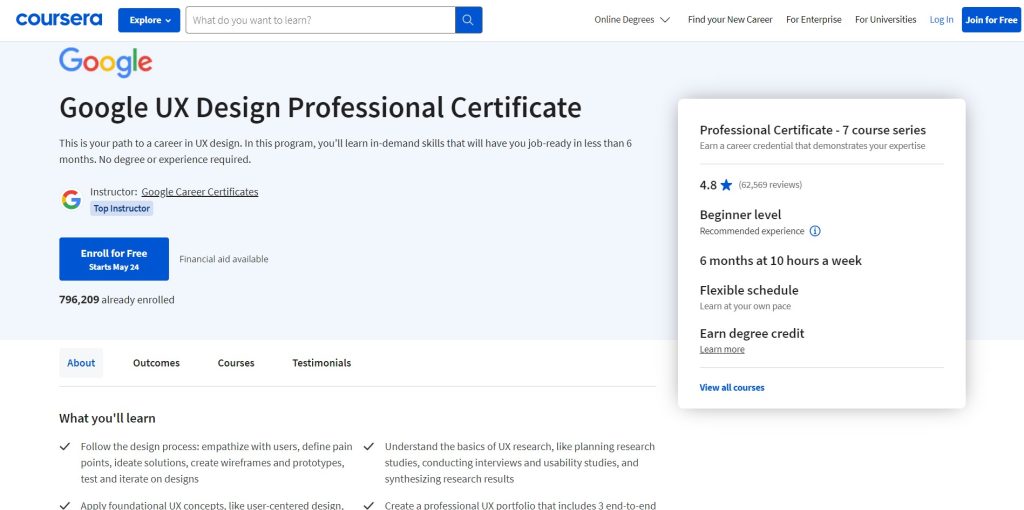
The Google UX Design Professional Certificate on Coursera provides a comprehensive introduction to UX design for beginners. The course does an excellent job covering foundational basics in an approachable manner for beginners.
It provides good practice in soft-skill-based parts of the process, like personas, empathy maps, affinity diagrams, and problem statements. The instructors are well-chosen, delivering concepts in a friendly, easy-to-understand manner.
However, the course also has its share of drawbacks. The peer-graded assignment system has been criticized, as assignments are evaluated by other beginners, making feedback less reliable and informative. Another critique is that the course is Google-centric, focusing on Google’s approach to UX and largely omitting other important design philosophies like iOS design patterns.
While it provides a good starting point, it’s not a guarantee of landing a job. The certificate can boost a junior designer’s confidence, but building a strong portfolio and further learning are also necessary.
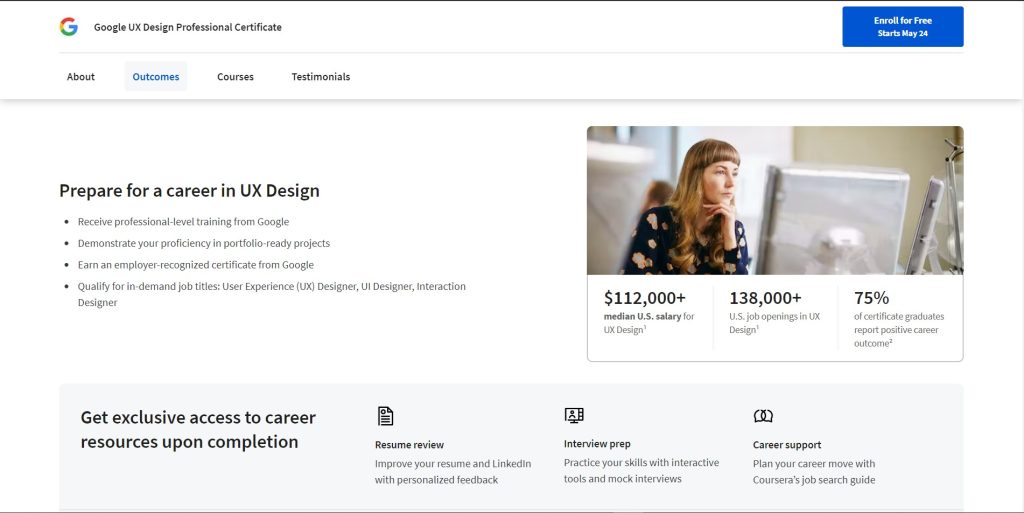
Key Features:
- UX Design Fundamentals
- Real-world projects
- Portfolio-building guidance
Why You Should Consider:
This course is perfect for beginners looking for a comprehensive and free introduction to UX design.
2) Introduction to UX Design by Georgia Tech (Coursera)
A beginner-friendly introduction to the world of User Experience Design, designed to equip you with the foundational understanding of UX principles and methodologies.
- Price: Free,
- Duration: self-paced course, usually 4 weeks at 2-3 hours per week.
- Ideal For: Individuals interested in UX design, beginners in the design field, and anyone looking to understand the basics of UX.
- Website: Introduction to User Experience Design
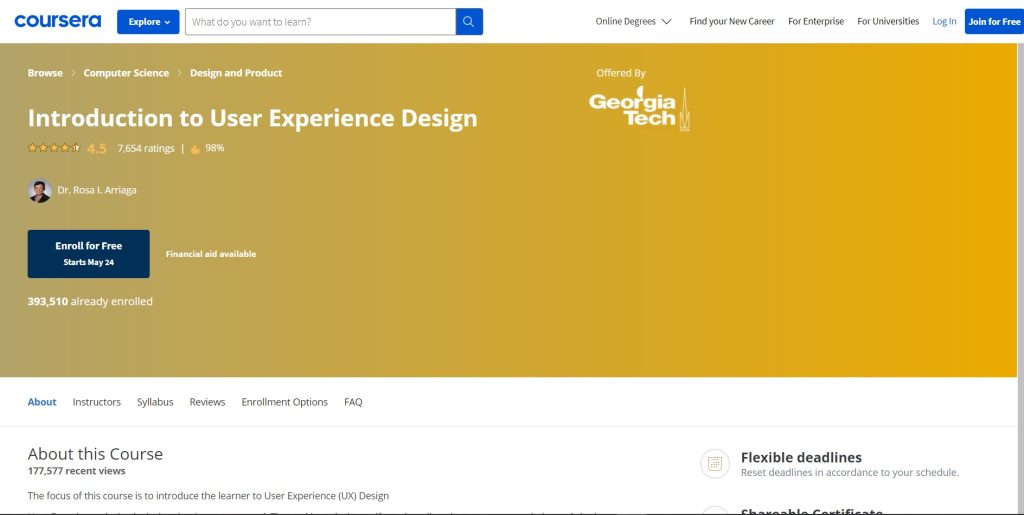
The Introduction to User Experience Design course by Georgia Tech, available on Coursera, is a highly accessible entry point for those new to the UX field. Taught by Dr. Rosa I. Arriaga, a Senior Research Scientist from Georgia Tech, the course offers a solid understanding of basic UX concepts.
The course is a beneficial starting point for individuals looking to delve into UX design or expand their knowledge. It covers fundamental topics in UX design and provides learners with an understanding of the process from the initial concept to the final design.
Please note while the course is free, there is a cost associated with obtaining a certificate. Also, although it’s self-paced, staying on track with the suggested timeline (approximately 4 weeks at 2-3 hours per week) will likely provide the most benefit.
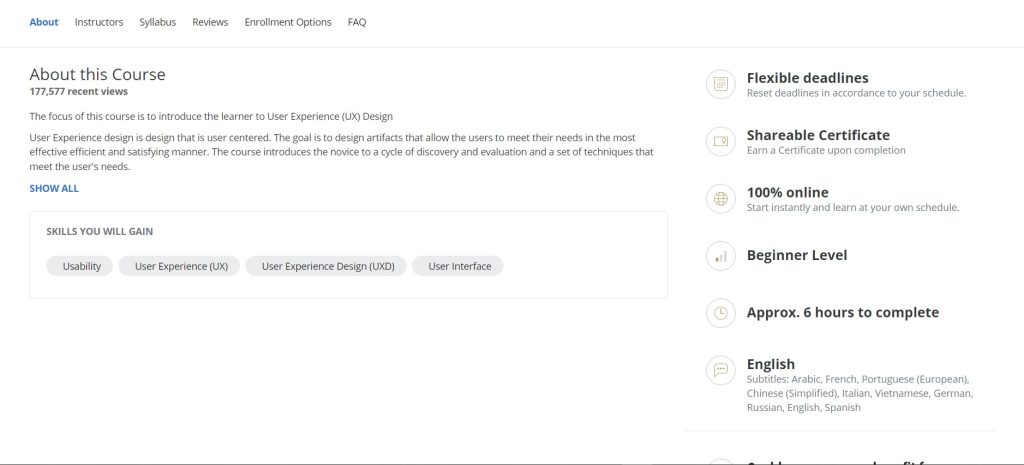
Key Features:
- User-centered design principles
- Usability evaluation methods
- Introduction to interaction design
Why You Should Consider:
If you are new to UX design and want a brief, free introduction, this course is a great starting point.
3) UX Research and Design by UMich (Coursera)
A thorough specialization providing foundational understanding and practical skills in User Experience Research and Design.
- Price: $49/month with a 7-day free trial period
- Duration: Self-paced, typically completed in three to six months with about 10 hours of study per week.
- Ideal For: Individuals looking to break into the field of UX design or professionals seeking to strengthen their UX skills.
- Website: User Experience Research and Design
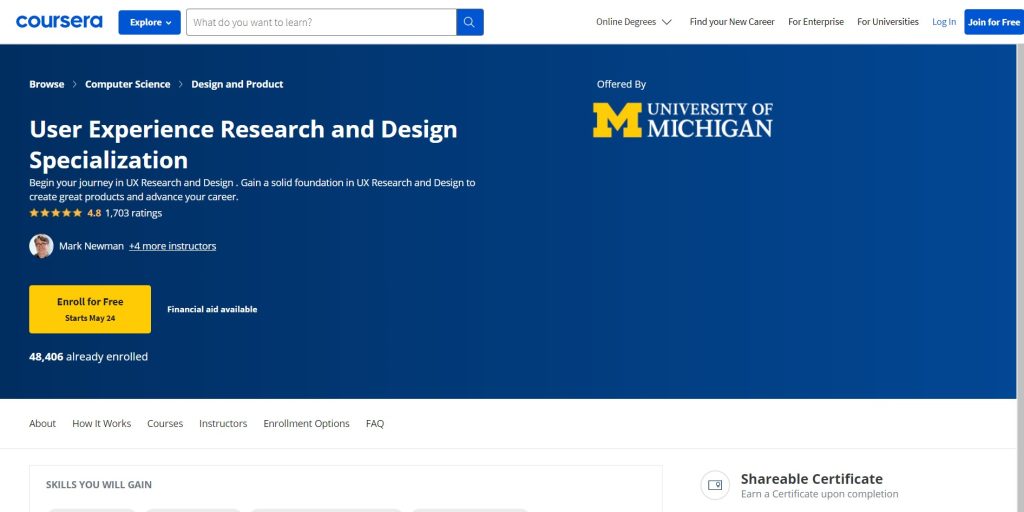
The University of Michigan’s User Experience Research and Design Specialization on Coursera is a well-regarded course offering a blend of theory and practical application. According to one source, it’s a great way to sharpen both design and research skills without breaking the bank, making it ideal for those looking to develop their technical expertise in UX design.
Despite its strong emphasis on providing a solid foundation, there are a few criticisms to consider. For instance, one review of a similar Google UX Design Certificate course on Coursera noted the issues with the Coursera platform itself, such as poor user experience that could impact the learning process.
The course has been praised for its comprehensive approach and quality instruction. It covers the foundational basics quite well, making it approachable for complete beginners. The instructors are well-chosen, and the course content is friendly, concise, and easy to understand. While the course is not particularly difficult, it offers a solid starting point for newcomers in UX design, providing them with foundational skills that could aid further learning and exploration.
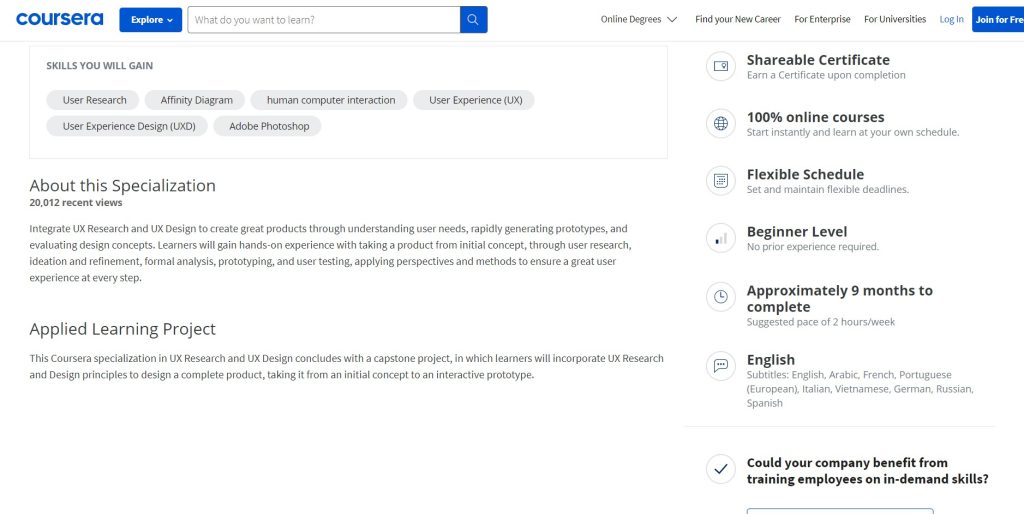
Key Features:
- UX research methods
- Data analysis techniques
- Design iteration based on research findings
Why You Should Consider:
This course is ideal for learners who have a basic understanding of UX design and want to delve deeper into UX research and design methodologies.
4) UI/UX Design Specialization by CalArts (Coursera)
A comprehensive specialization that covers both UI and UX design principles and practices.
- Price: Free
- Duration: 8 months
- Ideal For: Beginners and intermediate learners
- Website: UI/UX Design Specialization
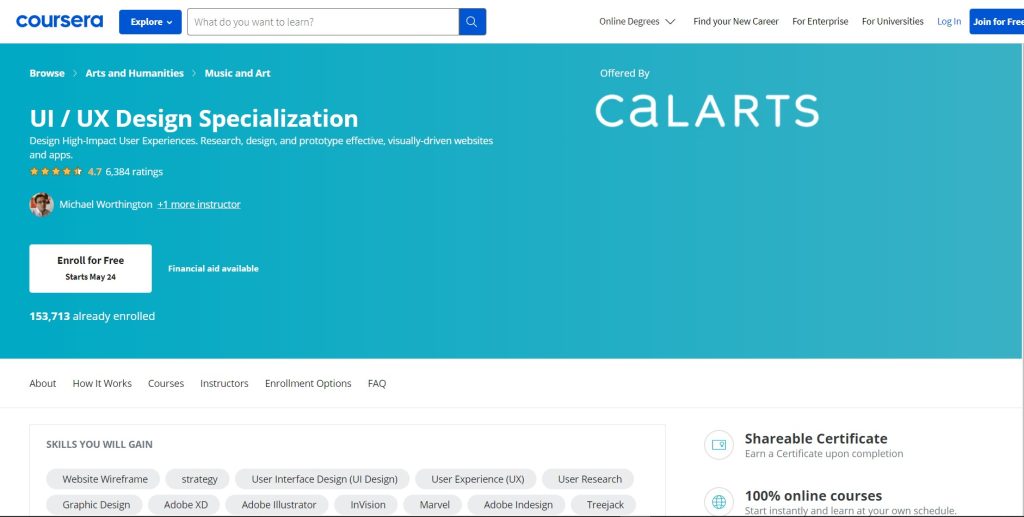
The UI/UX Design Specialization by CalArts on Coursera aims to prepare learners to apply design principles in creating effective user interfaces and user experiences. It’s a comprehensive specialization that equips learners with the necessary skills for a UI/UX design career.
The program offers a structured approach, from the basics of visual communication to applying knowledge in a design-centric capstone project.
With a focus on hands-on learning, it allows learners to build a portfolio of work that can be showcased to potential employers. However, the reviews regarding this course’s effectiveness in preparing learners for real-world job scenarios are somewhat mixed, indicating that additional resources or learning may be needed to prepare for a career in UX design fully.
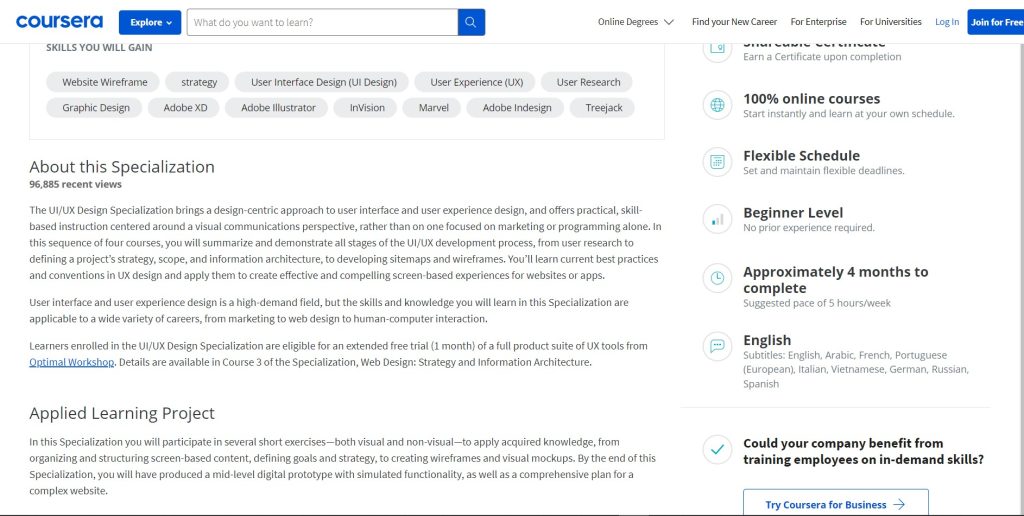
Key Features:
- Comprehensive UI/UX design curriculum
- Hands-on projects
- Portfolio-building guidance
Why You Should Consider:
This course suits learners interested in both UI and UX design and want a comprehensive program covering both disciplines.
5) CareerFoundry’s UX Design Short Course
An immersive, online program geared towards equipping learners with the fundamentals of UX Design.
- Price: Free
- Duration: 1 week
- Ideal For: Beginners
- Website: CareerFoundry UX Design Short Course
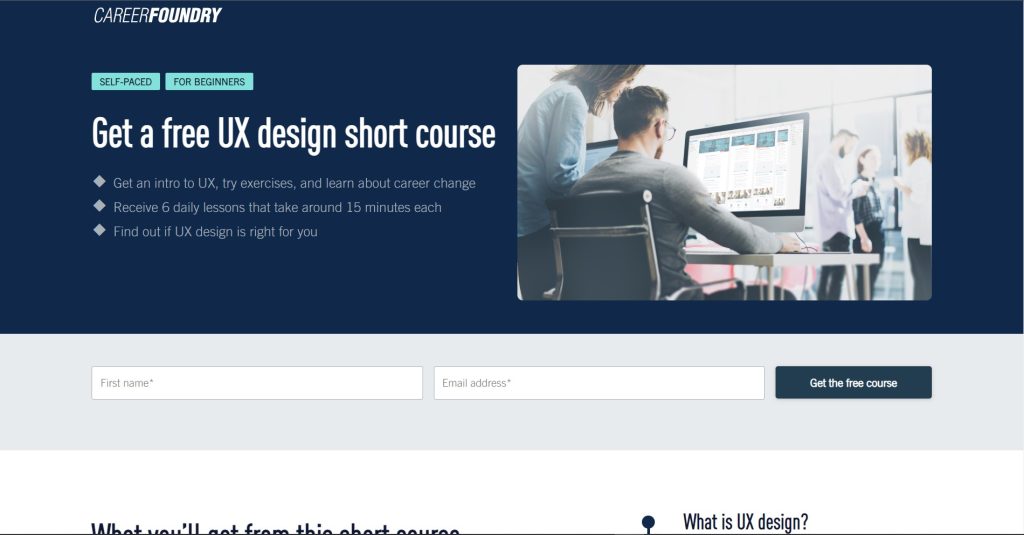
CareerFoundry’s UX Design Short Course provides a comprehensive introduction to the field of UX design. It gives learners a good understanding of what UX design is and what a UX designer does, making it ideal for those new to the field.
The course is known for its ability to present complex concepts in a way that is easy to understand and digest, covering key aspects of the UX profession, including designing interfaces, conducting user research, and creating effective designs.
The short course allows learners to gain practical skills and knowledge that they can apply immediately in their projects. It’s also praised for offering a wealth of resources and materials that learners can use beyond the course itself.
However, it’s important to note that while the course provides a solid foundation, becoming proficient in UX design will require continuous learning and practice beyond this short course.
One aspect of the course that stands out is the emphasis on real-world application. Learners are encouraged to apply what they’ve learned in various projects, allowing them to work on practical assignments that mimic real-world challenges faced by UX designers.
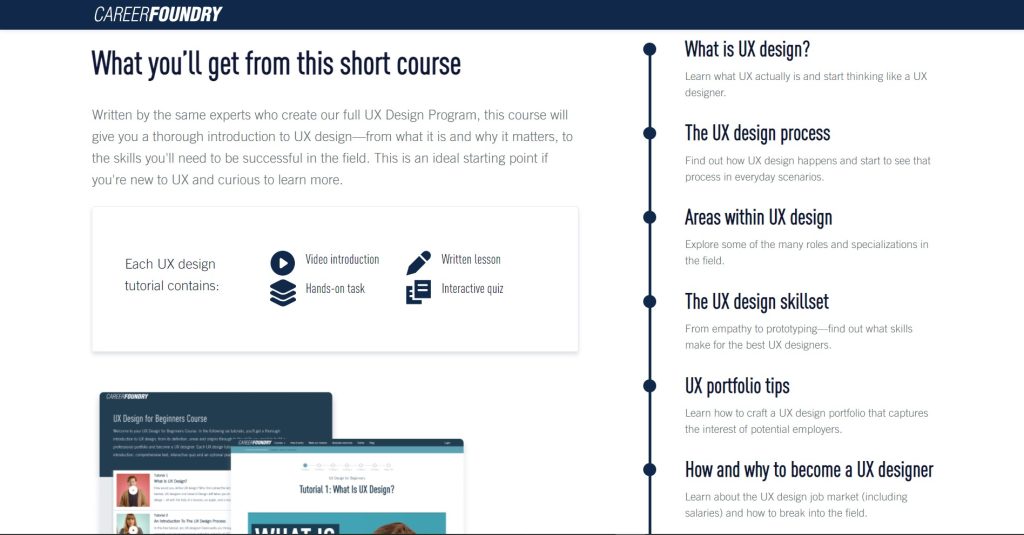
Key Features:
- UX design introduction
- Emphasis on practical skills and real-world application
- Access to a wealth of resources and materials
Why You Should Consider:
It’s a great starting point for those interested in learning the basics of UX design and applying these concepts to real-world projects.
6) General Assembly’s Intro to UX Design
A free introductory course designed to provide a foundational understanding of user experience (UX) design principles.
- Price: Free
- Duration: 1 session (2 hours)
- Ideal For: Beginners
- Website: General Assembly Intro to UX Design
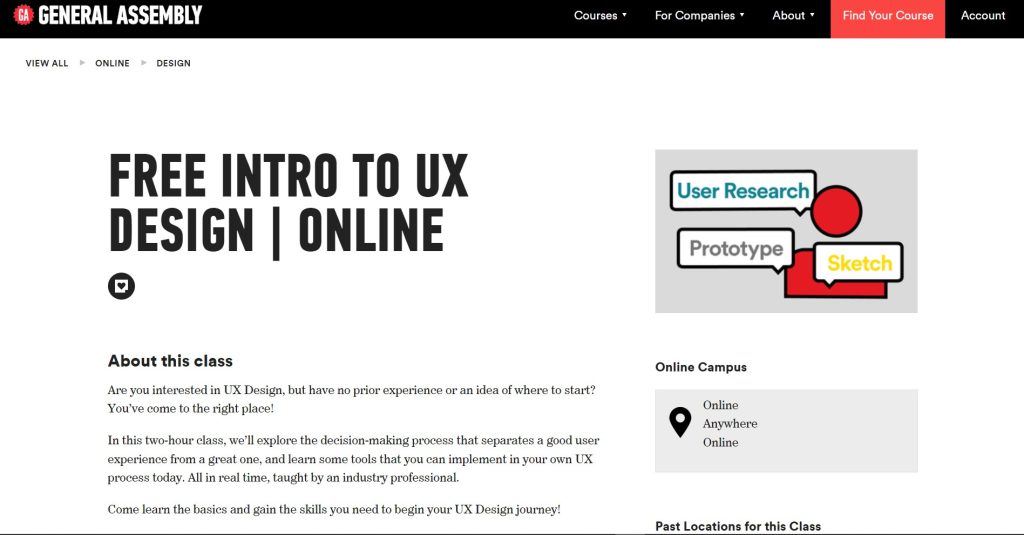
General Assembly’s Intro to UX Design is a free entry point into the intriguing world of UX design. This course is a strategic first step for those considering a career in the field, offering insights that help them evaluate their suitability for this profession.
This introductory course provides a snapshot of the UX design landscape, allowing learners to explore their interests and aptitude before committing to a full-fledged UX training program.
It offers a no-risk exploration of UX design, guiding learners in their decisions about pursuing a more in-depth education in this sphere.
Moreover, transitioning from this foundational course to General Assembly’s more comprehensive offerings has proven successful for many. The immersive courses provide structured learning, foster accountability, and equip students with practical project experience.
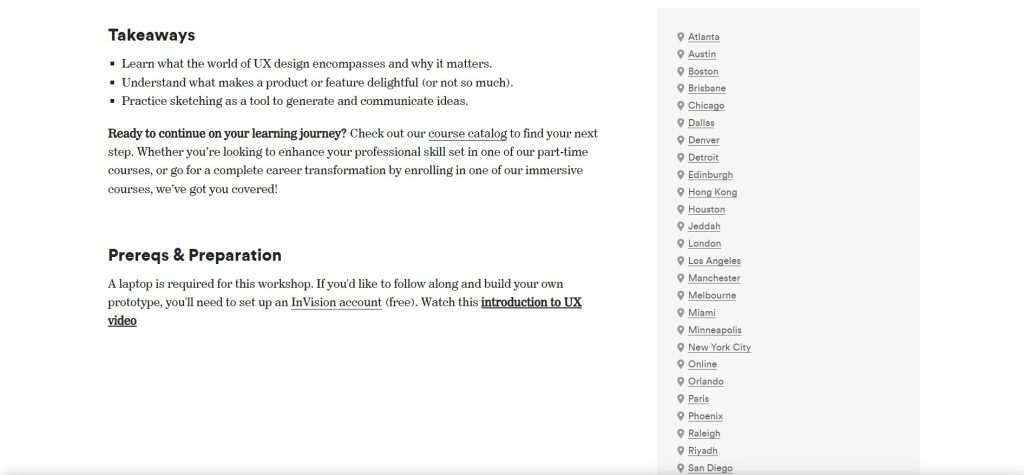
Key Features:
- Learn about the basics of UX design
- Understand how to create user personas and user journeys
- Learn how to create wireframes and prototypes
Why You Should Consider:
This free workshop is ideal for those who want a hands-on introduction to UX design in a short time frame.
7) Springboard’s free UX Design Course
A self-paced, free UX design introduction that covers fundamental concepts and techniques.
- Price: Free
- Duration: 40+ hours
- Ideal For: Beginners
- Website: Springboard UX Design Course
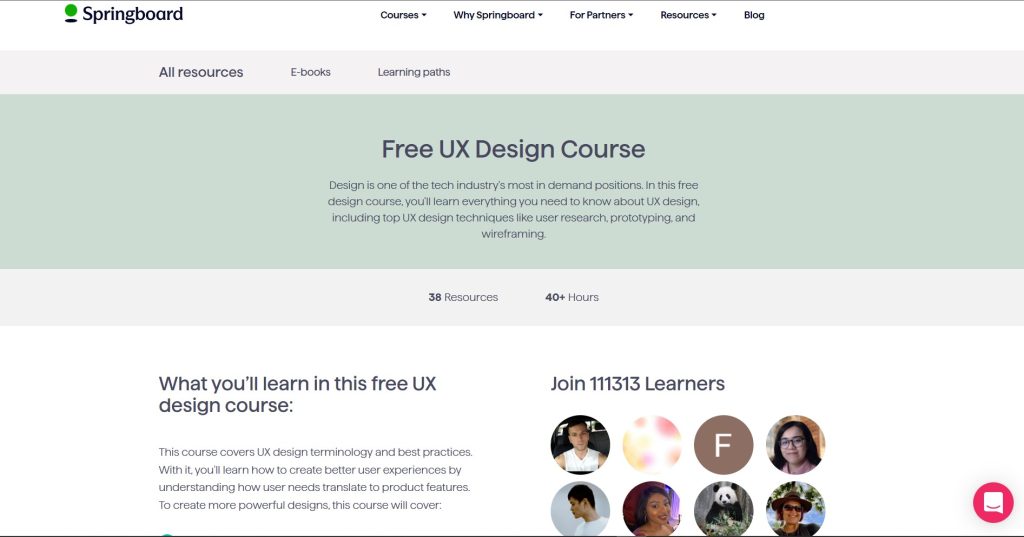
Springboard’s free UX Design Course provides a solid foundation in UX design and research while also offering hands-on training in industry-standard tools like Figma and Sketch.
The course encompasses a variety of topics, including design research, user-centric design techniques, user interviews, persona creation, wireframe and prototype design, iterative testing, and accessibility principles. This self-paced online course emphasizes a project-based learning approach and offers a wealth of resources for learners to explore.
This beginner-friendly course requires only basic internet navigation skills. With its flexible scheduling, career-focused curriculum, and lifelong access to lessons, it serves as a comprehensive starting point for learners. It also prepares students for further advanced studies or careers in UX design, enabling them to sharpen their skills through guided instruction or individual projects.
Previous students of this course have found it comprehensive, engaging, and practical. They have commended the quality of the resources, the instructor’s approach, and the real-world examples and exercises.
Moreover, after completing the course, some students have noted an increase in confidence, an improvement in their portfolio, and career advancement in UX design.
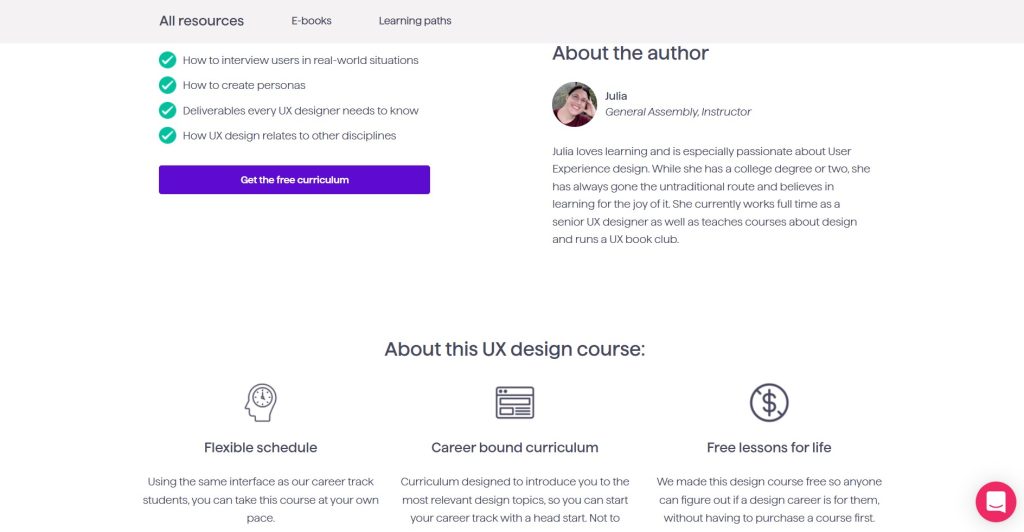
Key Features:
- Self-paced learning
- Use industry-standard tools such as Figma and Sketch
- Variety of learning materials
Why You Should Consider:
This free resource is a comprehensive and flexible introduction to UX design with a career-focused curriculum and lifelong access to lessons.
8) InVision’s Principles of UX Design
A free e-course that covers foundational UX design principles and best practices.
- Price: Free
- Duration: 21 hours
- Ideal For: Beginners
- Website: InVision Principles of UX Design
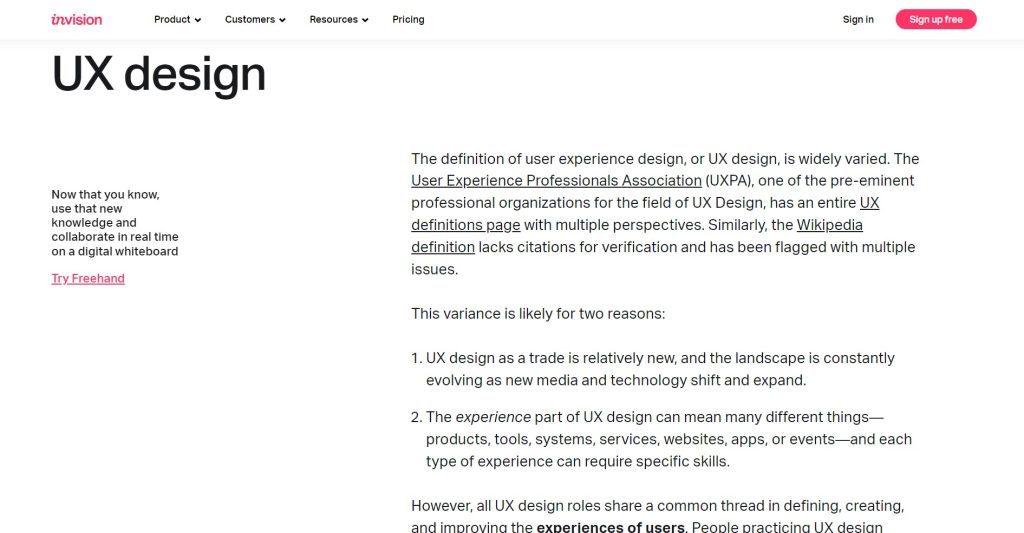
InVision’s Principles of UX Design course offers a deep dive into the fundamentals of UX design and research, along with practical training on the InVision platform for prototyping and collaboration.
The course, taught by seasoned UX professionals from Meta, covers key aspects such as user problem identification, empathy, persona creation, wireframe and prototype design, iterative testing, and application of accessibility principles.
This course, designed for beginners with basic internet navigation skills, is delivered 100% online and allows learners to move at their own pace. The flexible deadlines and a certificate upon completion add to its appeal.
Additionally, learners gain access to Figma, a potent tool for design creation and prototyping, allowing for hands-on experience either by following the instructor’s lead or working on independent projects.
Past learners have lauded the course for its clarity, engagement, and practicality. They’ve praised the quality of instructional videos, real-world examples, and exercises.
Furthermore, many have reported that the course has significantly enhanced their portfolios, assisted in job acquisition, or facilitated career advancement in UX design.
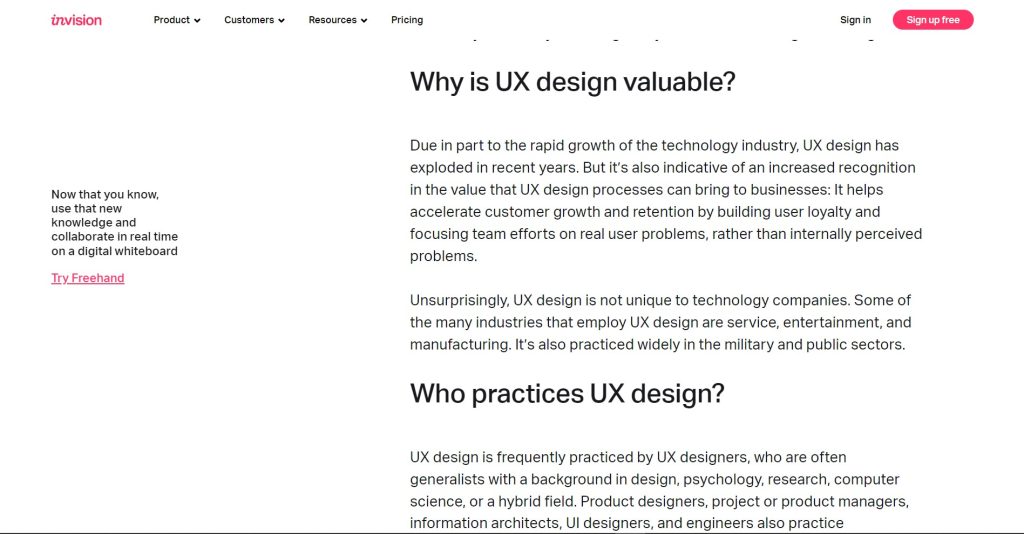
Key Features:
- Learn the fundamentals of user experience design and research
- Collaborate with teammates, and manage your UX design workflow
- Access Figma, a powerful tool for creating and prototyping designs
- Earn a shareable certificate upon completion
Why You Should Consider:
It’s an engaging and practical introduction to UX design taught by industry professionals, with access to powerful prototyping tools and flexible online learning.
9) The Gymnasium’s UX Fundamentals
A free online course that covers the basics of UX design, including research, prototyping, and testing.
- Price: Free
- Duration: 3-5 hours
- Ideal For: Beginners
- Website: The Gymnasium UX Fundamentals
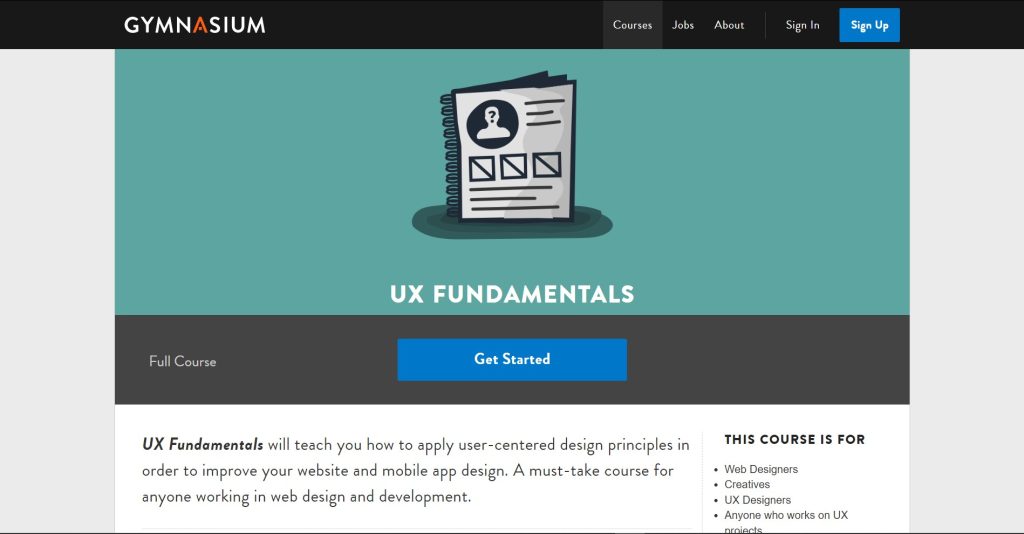
Gymnasium’s UX Fundamentals is an online, self-paced course that delves into the essentials of user experience design and research. It offers a practical curriculum, enabling learners to produce common UX deliverables such as personas, wireframes, and prototypes.
This project-based course spans a range of topics, including design research, user-centric design techniques, user interviews, iterative testing, and the application of accessibility principles. The learning journey is enriched with video lessons, quizzes, homework, and culminates in a final exam.
This course is designed for beginners, requiring basic internet navigation skills. It offers a flexible schedule, a career-oriented curriculum, and a certificate upon completion.
Learners can enhance their skills by either following the instructor’s guidance or working on individual projects. The course also serves as a springboard for more advanced UX courses or career paths.
Previous learners have given this course positive reviews, citing its comprehensive nature, engaging content, and practicality.
The instructor’s style, the quality of resources, real-world examples, and the exercises have also garnered appreciation.
Moreover, some learners have reported a boost in confidence, enhancement in their portfolio, and career advancement post-completion of the course.
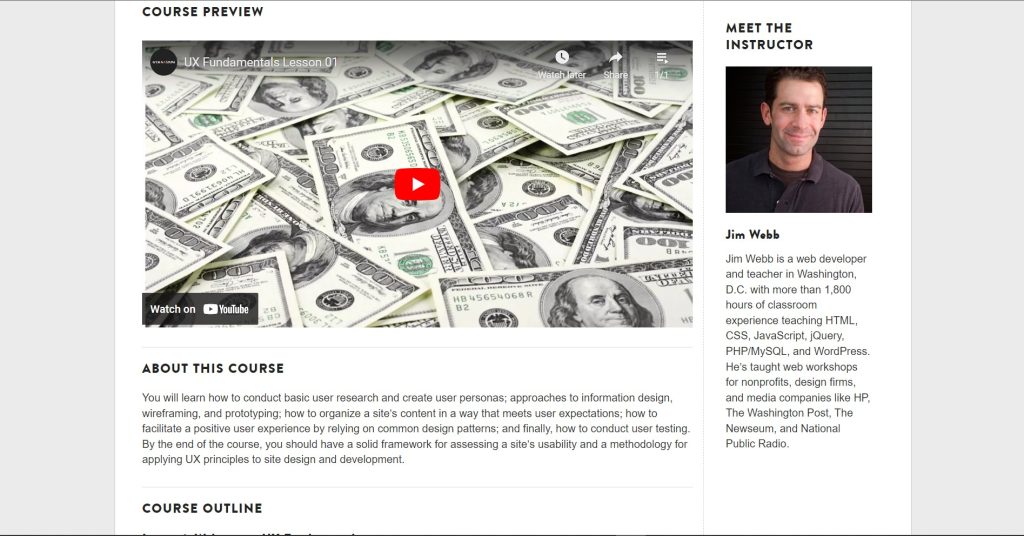
Key Features:
- Learn the fundamentals of user experience design and research
- Create common UX deliverables such as personas, wireframes, and prototypes
- Earn a certificate upon completion
Why You Should Consider:
Consider Gymnasium’s UX Fundamentals if you aspire to master the core concepts of UX design from industry experts and crave a practical, hands-on approach to crafting UX deliverables.
Best Paid UX Design Courses
1) DesignLab’s UX Academy
An intensive, project-based course that prepares students for a career in UX design.
- Price: $6,900 (or $499/month with deferred tuition)
- Duration: 15-30 weeks (depending on full-time or part-time option)
- Ideal For: Graphic, web, or digital designers who want to switch to product design
- Website: DesignLab UX Academy
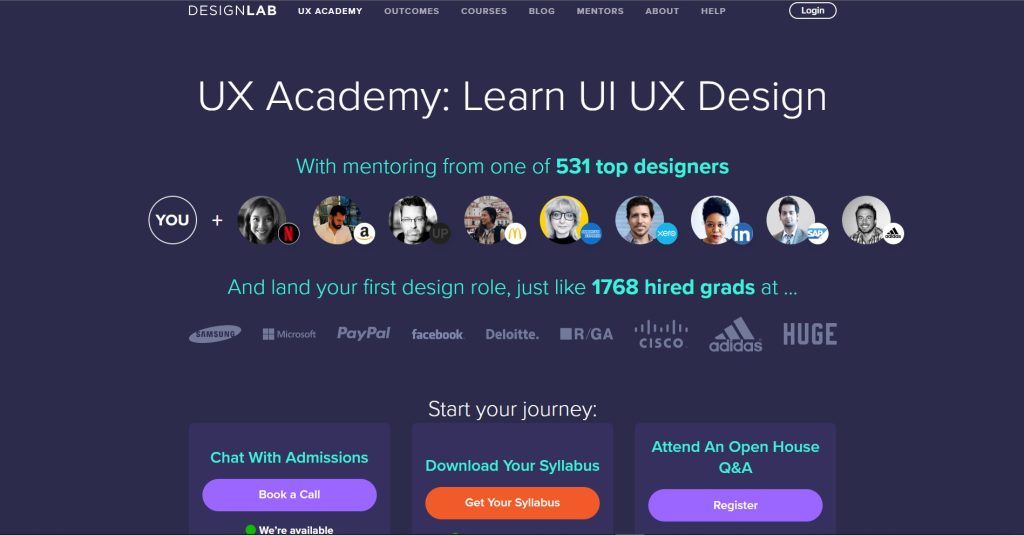
DesignLab’s UX Academy is an intensive online course that equips learners with the intricacies of UX/UI design, portfolio creation, and job search preparation.
The course delves into design research methods, user-centric design techniques, prototyping and testing, visual design principles, accessibility and ethics, and career development. It features video lessons, quizzes, homework, and a capstone project, providing a comprehensive, project-based learning experience.
Targeted at those with a graphic, web, or digital design background, or those who’ve completed the UX Academy Foundations course, this program offers both full-time and part-time options with flexible scheduling. It also provides a career-focused curriculum and a certificate upon completion.
Unique to this course is the 1-on-1 mentorship with a top designer and career coaching with a dedicated career specialist, ensuring personalized guidance throughout the learning journey.
The UX Academy course has garnered positive feedback for its comprehensive curriculum, engaging content, and practicality. Learners have commended the quality of resources, mentor guidance, and the opportunity to tackle real-world projects.
Furthermore, some learners have reported that this course has catalyzed their transition into product design roles at leading companies like Amazon, Microsoft, and Glassdoor.
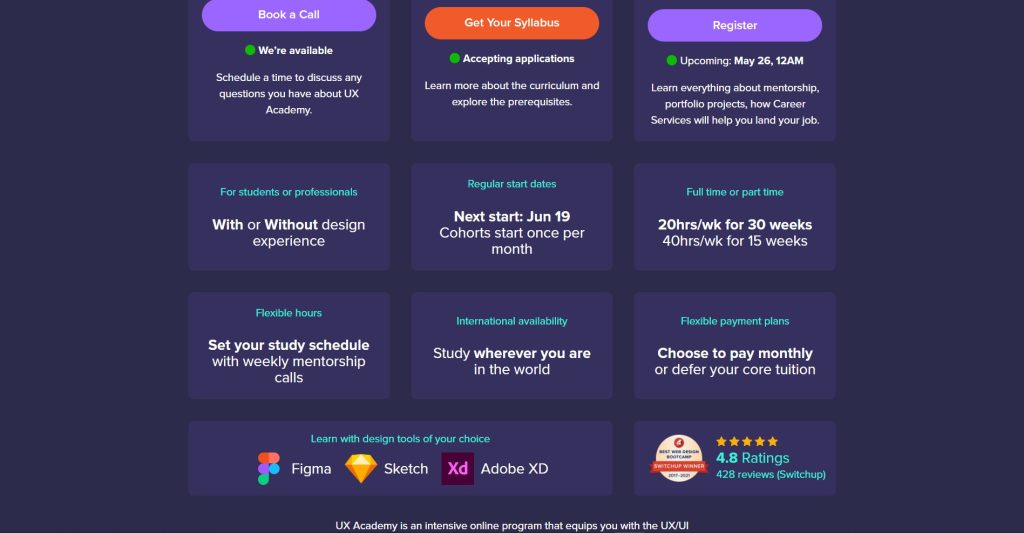
Key Features:
- Learn the skills and tools of UX/UI design
- Earn a certificate upon completion
- Receive 1-on-1 mentorship and career coaching
Why You Should Consider:
Consider DesignLab’s UX Academy if you have some design experience and are looking to transition into a product design career with expert mentorship and hands-on portfolio-building experience.
2) UX and Web Design Master Course (Udemy)
A course to learn how to apply UX principles to your website designs and code various sites.
- Price: $3,790 (or $599 with discount)
- Duration: 23.5 hours
- Ideal For: Beginners and intermediate learners
- Website: UX and Web Design Master Course
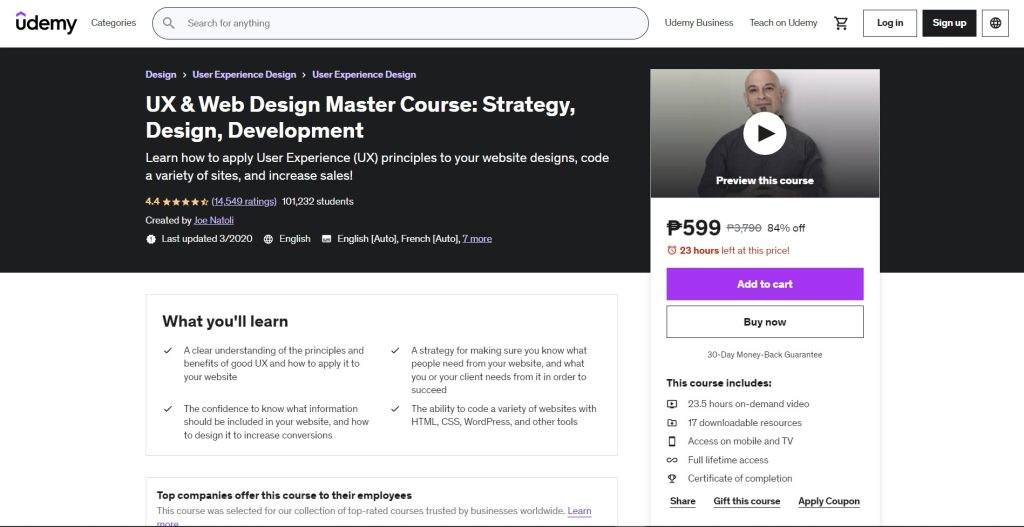
The Udemy’s UX and Web Design Master Course: Strategy, Design, Development is an online course that imparts the essentials of UX design and web development, including creating standard UX deliverables like personas, wireframes, and prototypes.
This course encompasses topics like design research methods, user-centered design techniques, prototyping and testing, visual design principles, accessibility and ethics, and career development, offering an online, self-paced, and project-based learning environment.
This course requires basic internet navigation skills, perfect for learners with no prior web development experience.
It offers a flexible schedule, a career-bound curriculum, and a certificate upon completion, setting learners up for more advanced courses or career tracks in UX design.
The UX and Web Design Master Course has earned positive reviews from past learners, who praise its comprehensive and engaging nature. They’ve highlighted the instructor’s practical teaching style, the quality of resources, and the practical examples and exercises that provide the chance to work on real-world projects.
Some learners have shared that the course has facilitated their entry into product design roles at leading companies such as Amazon, Microsoft, and Glassdoor.
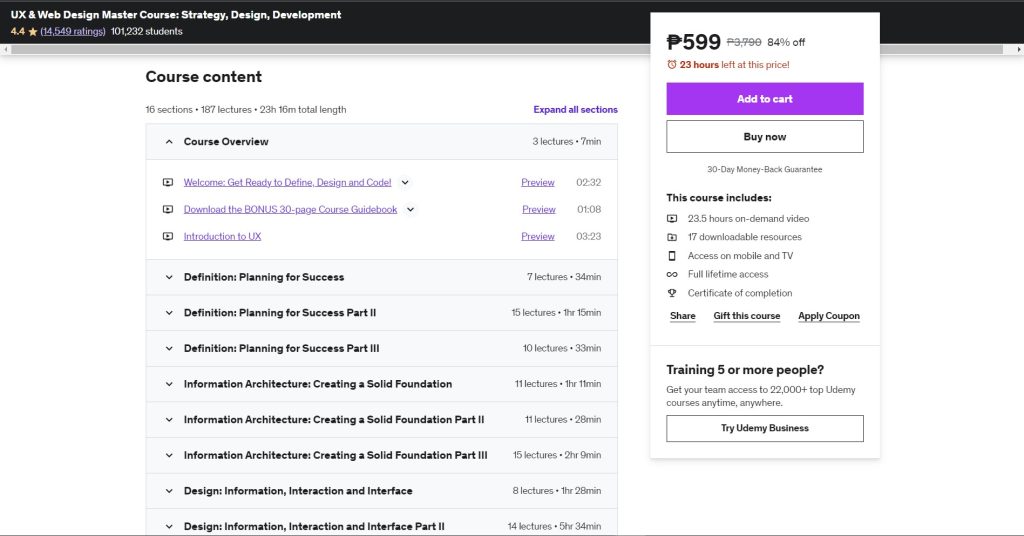
Key Features:
- Comprehensive UX and web design curriculum
- Hands-on projects
- Create common UX deliverables such as personas, wireframes, and prototypes
Why You Should Consider:
If you’re keen on infusing UX principles into your website designs and gaining hands-on web development experience, consider this course. It offers comprehensive learning and an Udemy certificate upon completion.
3) The Ultimate Guide to Usability and UX (Udemy)
A highly-rated course that covers UX design principles, usability testing, and user-centered design techniques.
- Price: $1,790
- Duration: 11.5 hours
- Ideal For: Beginners and intermediate learners
- Website: User Experience: The Ultimate Guide to Usability and UX
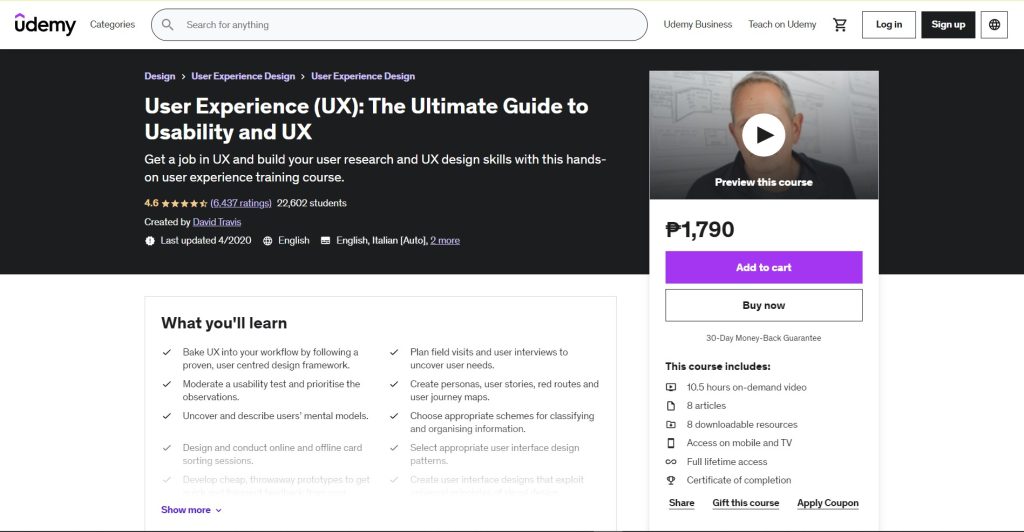
User Experience: The Ultimate Guide to Usability, a course by Dr. David Travis on Udemy, is a comprehensive gateway into the realm of user-centered design.
It encompasses an array of topics, including design research methods, user-centered design techniques, prototyping and testing, visual design principles, ethics, and career development.
Tailored for those without prior UX experience, basic internet navigation skills are the only prerequisite.
The course’s flexible scheduling, career-focused curriculum, and Udemy certificate upon completion cater to the diverse needs of learners.
Participants can either follow along with the instructor or undertake their own projects, thereby fostering hands-on skills development.
Furthermore, this course serves as a stepping stone to the BCS Foundation Certificate in User Experience.
The course has received an influx of positive reviews from learners, who commend its comprehensive and engaging structure, informative content, and practical approach.
The instructor’s teaching style, the high-quality resources, tangible examples and exercises, and the chance to engage with real-world projects have all received appreciation.
In fact, some learners have attributed their successful transition into product design roles at leading companies like Amazon, Microsoft, and Glassdoor to this course.
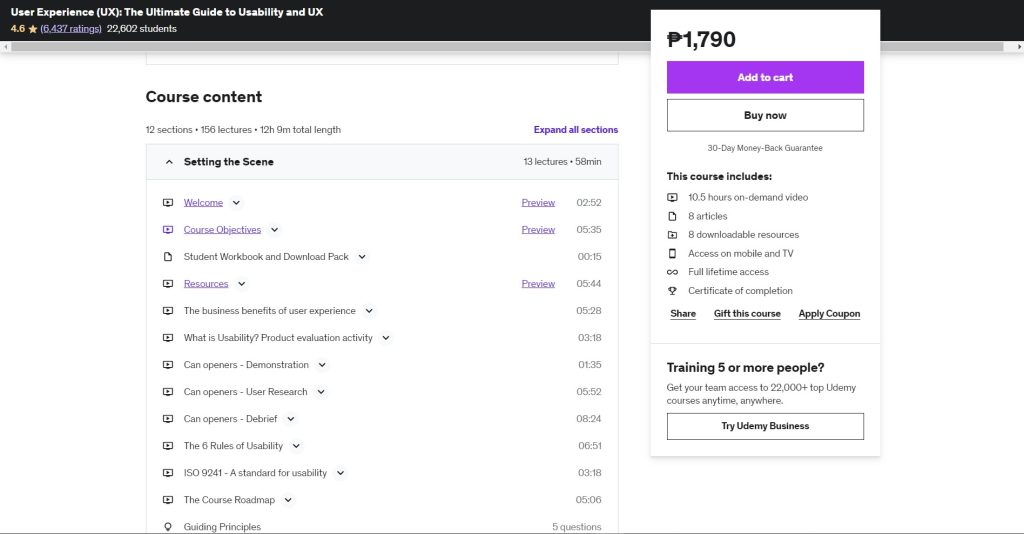
Key Features:
- Comprehensive UX design principles
- Usability testing techniques
- User-centered design methods
Why You Should Consider:
This course is a perfect fit for those aiming to master user research, usability testing, and applying UX principles to website designs while also preparing for the BCS Foundation Certificate in User Experience.
4) User Experience Design Essentials (Udemy)
A hands-on course that teaches UX design principles and Adobe XD software for creating interactive prototypes.
- Price: $3,790 (or $599 with discount)
- Duration: 12 hours
- Ideal For: Beginners and intermediate learners
- Website: User Experience Design Essentials — Adobe XD UI UX Design
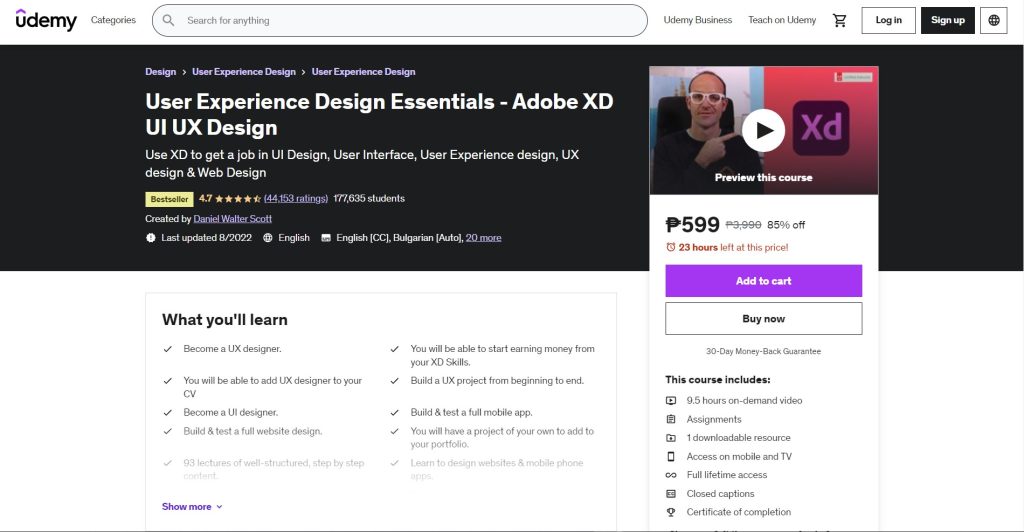
Udemy’s User Experience Design Essentials — Adobe XD UI UX Design, led by Adobe Certified Instructor Daniel Walter Scott, is a comprehensive guide to designing and prototyping user interfaces using Adobe XD.
The course provides an in-depth understanding of design principles, wireframing, prototyping, testing, animation, responsive design, and UI kits.
This course is well-suited for beginners without prior experience in Adobe XD or UI design and requires only basic computer skills.
It offers flexible scheduling, a career-oriented curriculum, and an Udemy certificate upon completion.
Learners can follow along with the instructor or work on their own projects, enabling skill development at their own pace.
The course has garnered numerous positive reviews for its comprehensive coverage, engaging content, and practicality.
The instructor’s style, high-quality resources, hands-on examples, and opportunities to work on real-world projects have been highly rated.
Many learners reported that the course significantly enhanced their UI design skills and portfolio.
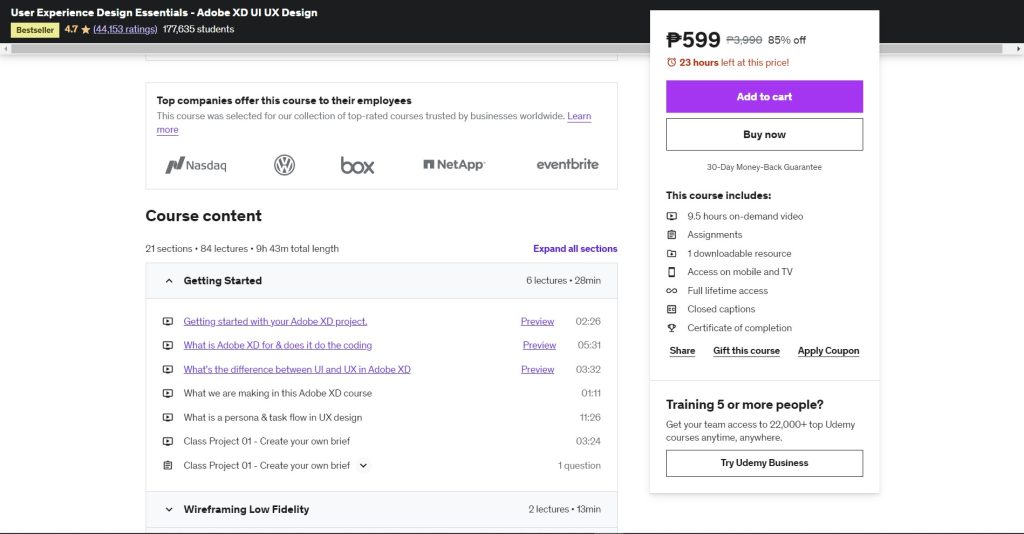
Key Features:
- Create websites and mobile apps with realistic interactions and animations
- Hands-on Adobe XD experience
- Interactive prototyping techniques
Why You Should Consider:
This course is ideal for anyone seeking to master Adobe XD for designing and prototyping user interfaces, with the added benefit of earning a certificate from Udemy.
5) UX: The Beginner’s Guide (Interaction Design Foundation)
A beginner-friendly course that covers the fundamentals of UX design, including research, design, and evaluation.
- Price: $13/month (Interaction Design Foundation membership)
- Duration: 2 days, self-paced
- Ideal For: Beginners
- Website: User Experience: The Beginner’s Guide
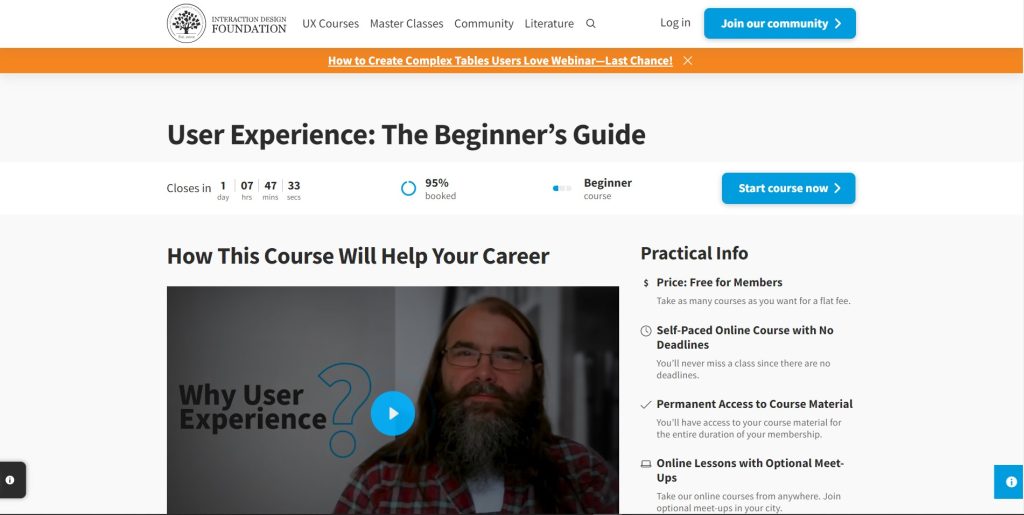
IDF’s course User Experience: The Beginner’s Guide is an ideal initiation into the world of UX design. It provides a detailed understanding of the role of a UX designer and the importance of UX design.
Furthermore, the course is well-organized and introduces practical techniques immediately applicable in a professional environment. Delivered by experienced professionals, this course stays current with the latest industry trends.
It isn’t highly technical and designed specifically for beginners interested in UX design or those planning to transition into a UX career. It may not be ideal for individuals seeking a deep, technical understanding of UX design.
The course has been lauded as a comprehensive introduction to UX design. Notably, it directs learners to other relevant courses for those interested in diving deeper into specific topics.
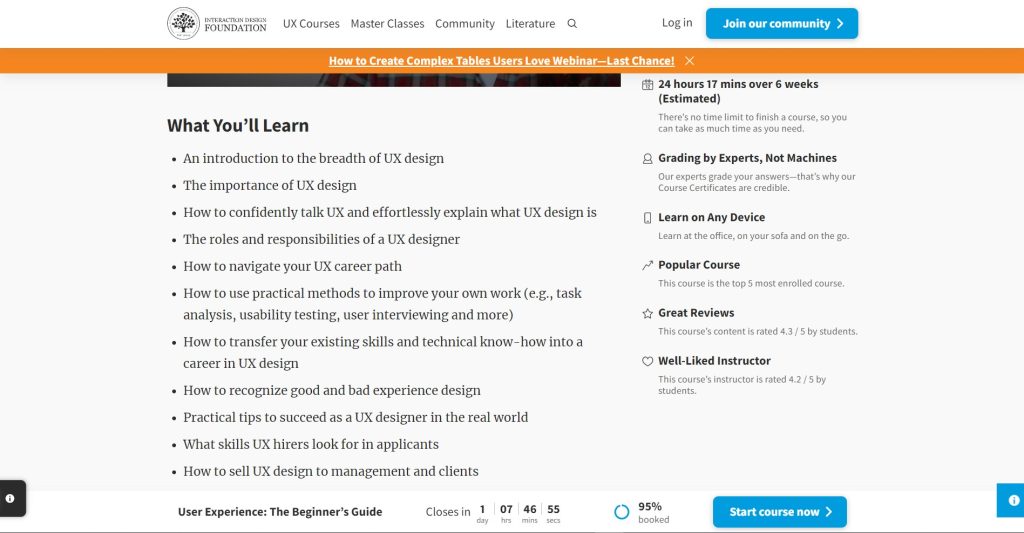
Key Features:
- Covers a wide range of topics related to UX design
- Practical methods that can be applied to work immediately
- Introduction to other courses that learners can take if they want to learn more about a specific topic
Why You Should Consider:
The course is an excellent choice for anyone seeking to grasp the basics of user experience design and start a UX career while also preparing for the BCS Foundation Certificate in User Experience.
6) Springboard UX Design Bootcamp
An intensive, project-based bootcamp that prepares students for a career in UX design.
- Price: $7,900 upfront (with various payment options)
- Duration: 6 months (15-20 hours a week)
- Ideal For: Beginners and intermediate learners
- Website: Springboard UX Design Bootcamp
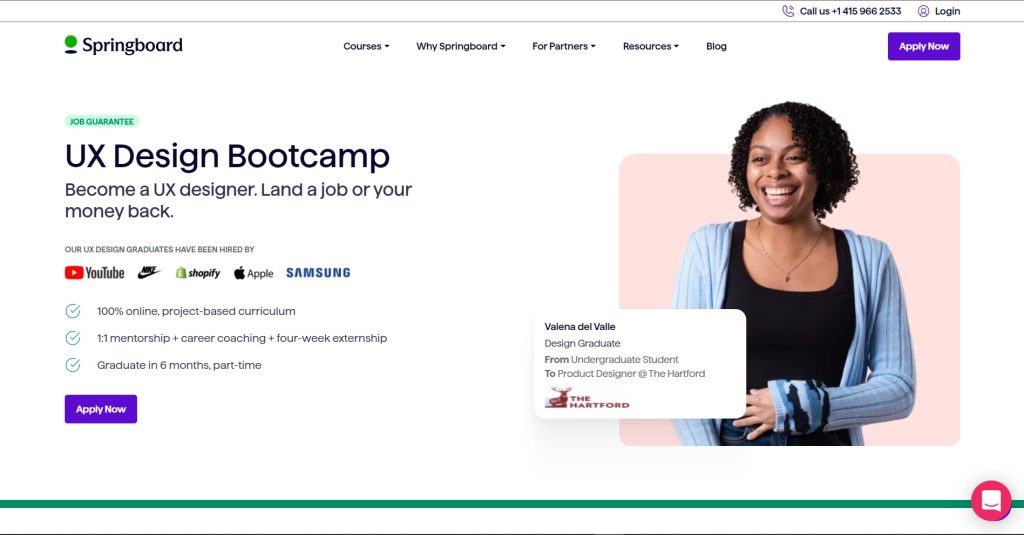
Springboard UX Design Bootcamp serves as a thorough guide to user research, user interface design, and how to land a position as a UX designer.
The course spans various topics, including design thinking, user research methodologies, prototyping, testing, UI design principles, and career advancement. Designed as an online, self-paced, project-centric program, it comprises video lectures, quizzes, assignments, and a final exam.
This bootcamp is a fit for those with no prior UX experience, requiring only basic skills in internet navigation. It offers a flexible timetable, a career-oriented curriculum, and a completion certificate.
Learners can apply their knowledge via nine mini-projects, a design sprint, and a capstone project. Unique to this course is the provision of one-on-one mentorship from an industry professional and career coaching from a dedicated specialist.
Past learners have lauded the course, recognizing its comprehensiveness, engagement, and practicality.
They have expressed appreciation for the mentorship, quality of resources, practical examples and exercises, and the chance to work on real-world projects.
To this course, some learners have attributed their successful onboarding into UX design roles at leading firms like Amazon, Microsoft, and Glassdoor.
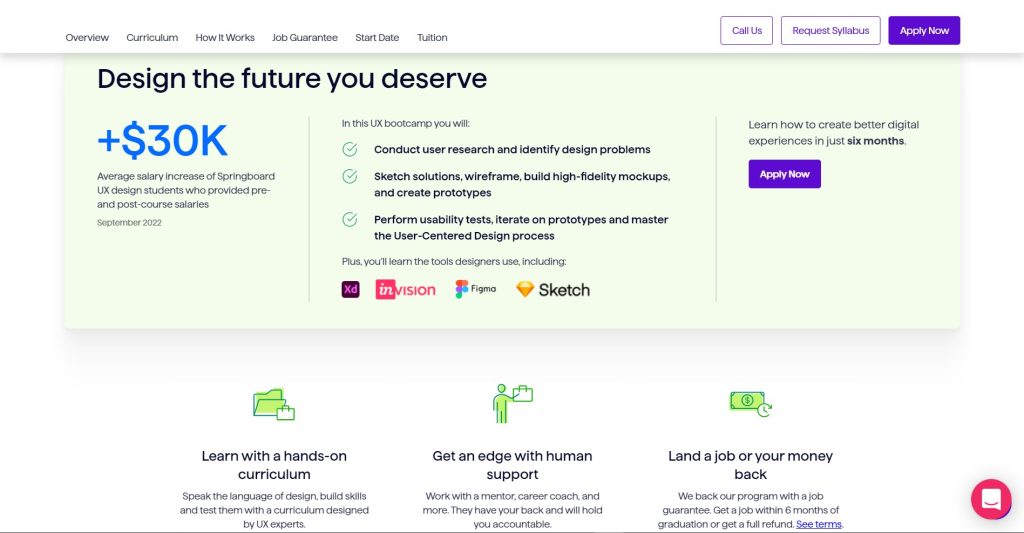
Key Features:
- Learn how to conduct user research and design user interfaces
- Receive 1-on-1 mentorship and career coaching
- Get a job guarantee or your money back
Why You Should Consider:
This bootcamp is perfect for learners serious about pursuing a career in UX design and wanting an intensive, project-based learning experience with personalized mentorship.
7) UX Design Course (General Assembly)
An immersive course that covers UX design principles, research, prototyping, and testing.
- Price: $13,950
- Duration: 10 weeks (full-time) or 24 weeks (part-time)
- Ideal For: Beginners and intermediate learners
- Website: General Assembly UX Design Course
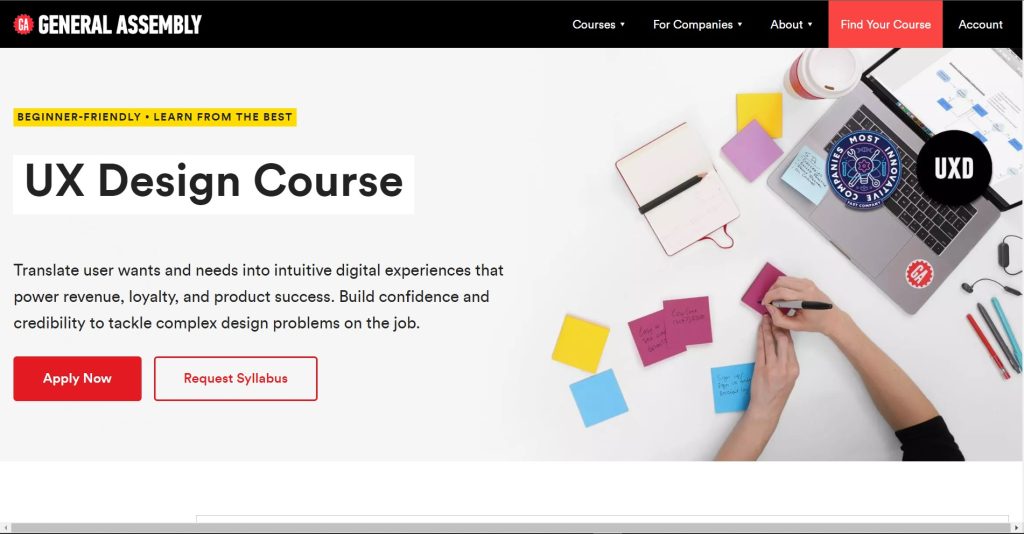
The General Assembly UX Design Course delivers a well-rounded program equipped with the tools necessary to cultivate proficient UX designers.
The curriculum spans a variety of topics, including user research, prototyping, user testing, and design critique. Taught by professionals with industry experience, the course remains current with up-to-date practices. It is suitable for those seeking to understand UX design or pivot into a UX design career.
The course boasts a well-organized, easily digestible structure, incorporating practical methodologies that can be immediately applied to work scenarios. It provides a comprehensive overview of the UX design process and a UX designer’s duties.
Students are guided to convert user requirements into intuitive digital experiences that drive revenue, loyalty, and product success. Additionally, the course includes preparatory lessons to ensure students are primed for success.
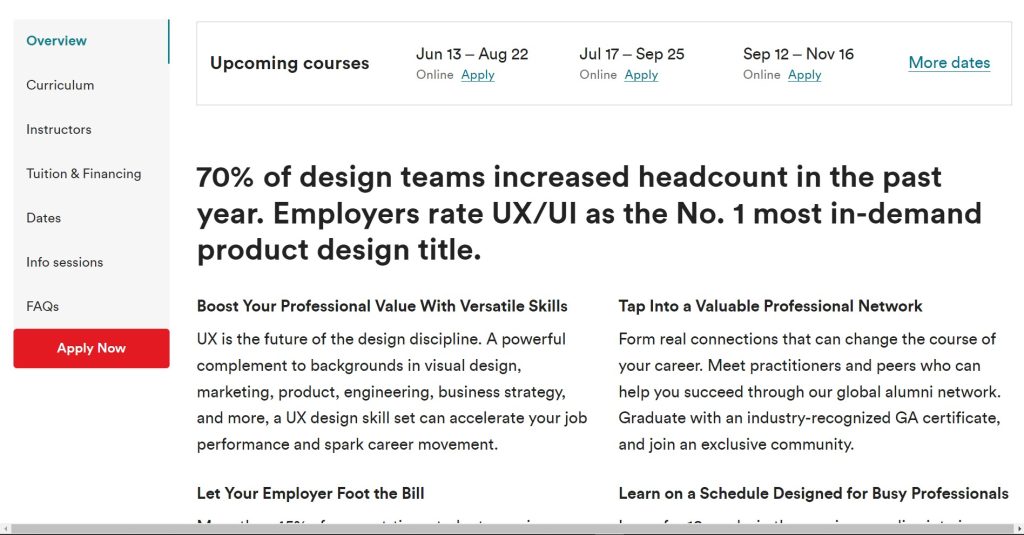
Key Features:
- Covers a wide range of topics related to UX design
- Practical methods that can be applied to work immediately
- Includes pre-course preparatory lessons to set students up for success
Why You Should Consider:
If you seek a thorough UX design course offering a broad spectrum of topics and immediate, practical application, the General Assembly UX Design Course is your ideal choice.
8) Flatiron Product Design Bootcamp
A project-based course that teaches UX design, user research, and product management skills.
- Price: $16,900 (with various payment options available)
- Duration: 15 weeks for the full-time program, 40 weeks for the part-time program
- Ideal For: Beginners and intermediate learners
- Website: Flatiron Product Design Bootcamp
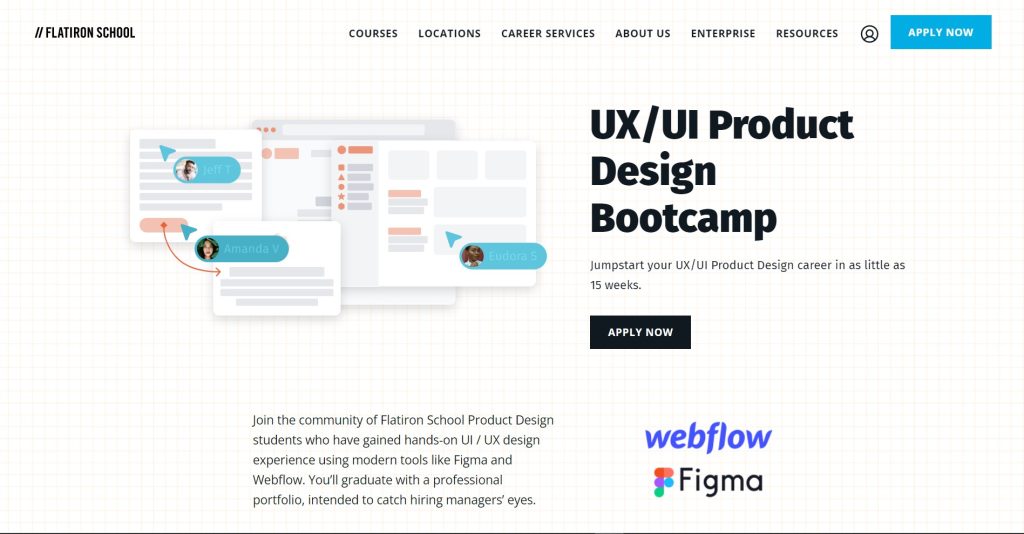
The Flatiron Product Design Bootcamp offers an inclusive program that equips students with the necessary skills for a successful UX/UI design career. The course is structured in five phases, focusing on the user experience (UX) process.
Students will become familiar with design tools such as Figma, Invision, and Webflow and gain foundational UX/UI design knowledge. Instructor Anwar Montasir brings 20 years of experience as a designer, developer, educator, and curriculum writer.
The program is available in both full-time and part-time formats, with the latter being self-paced over 40 weeks. The course includes a preparatory curriculum detailing the course structure and an overview of design tools.
Students will also be able to partake in Flatiron School’s community events and network with peers from other cohorts. Post-graduation, students can avail up to 180 days of individual career coaching to facilitate their entry into the digital industry.
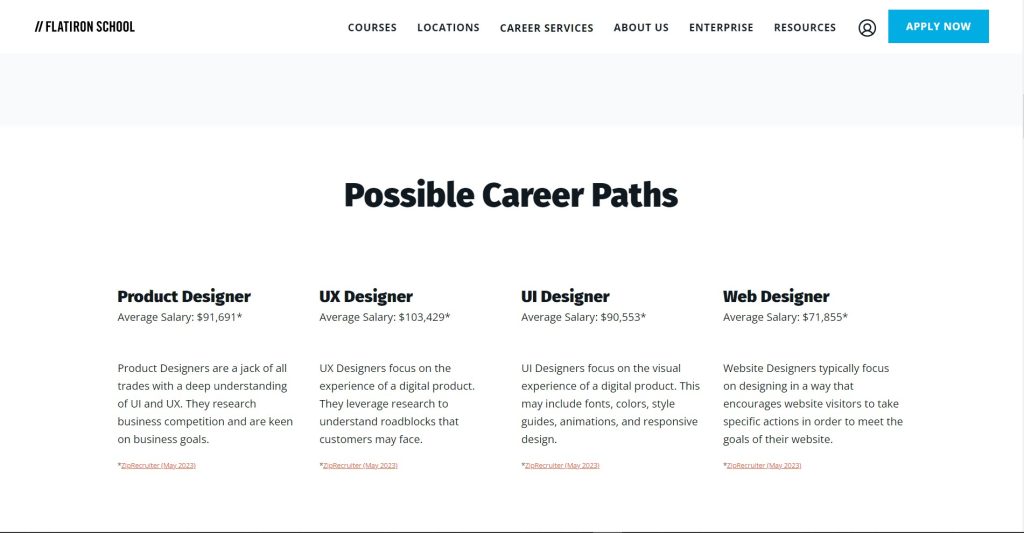
Key Features:
- Comprehensive curriculum that covers the UX/UI design process and design tools
- Available in both full-time and part-time formats
- Includes career coaching to help students find a job in the digital industry
Why You Should Consider:
The Flatiron Product Design Bootcamp is a fantastic choice if you aim to build a solid UX/UI design foundation, learn from an industry veteran, and receive dedicated career support to land a job in the digital industry.
9) Intro to User Design (SuperHi)
A beginner-friendly course that teaches UX design principles and hands-on skills using Figma.
- Price: Price: $149 (or access to all courses for $360/year with SuperHi Unlimited)
- Duration: Price: $149 (or access to all courses for $360/year with SuperHi Unlimited)
- Ideal For: Beginners
- Website: Intro to User Design
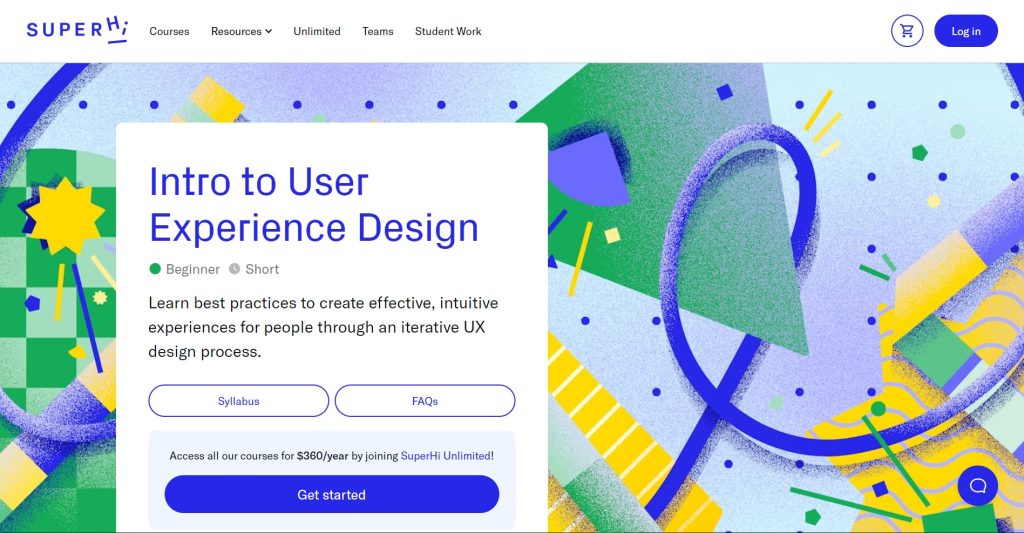
The SuperHi UX Design course is a well-rounded offering that guides students through the entire UX design process. Beginning with user research, the course walks you through wireframing, prototyping, UI design, and user testing. It’s designed to foster a UX designer’s mindset and builds confidence to take on projects independently or for clients.
This course offers a practical, self-paced structure, making it suitable for anyone who can comfortably navigate a computer. It utilizes Figma as its primary design and prototyping tool, with SuperHi students accessing Figma Pro features.
The course provides an enriching environment with real-world projects, valuable resources, and a supportive community of students and alumni. Notably, the course requires no prior coding knowledge or UX design experience.
The course features instructors Milan Moffatt and Kristen Altomare-Ciallella, both of whom bring a wealth of professional experience and accolades to the teaching experience.
The course consists of 6 hours of video lessons, which can be paced according to the student’s convenience. However, it’s important to note that the actual time to complete the course may vary depending on how much time you spend on exercises, projects, and self-study.
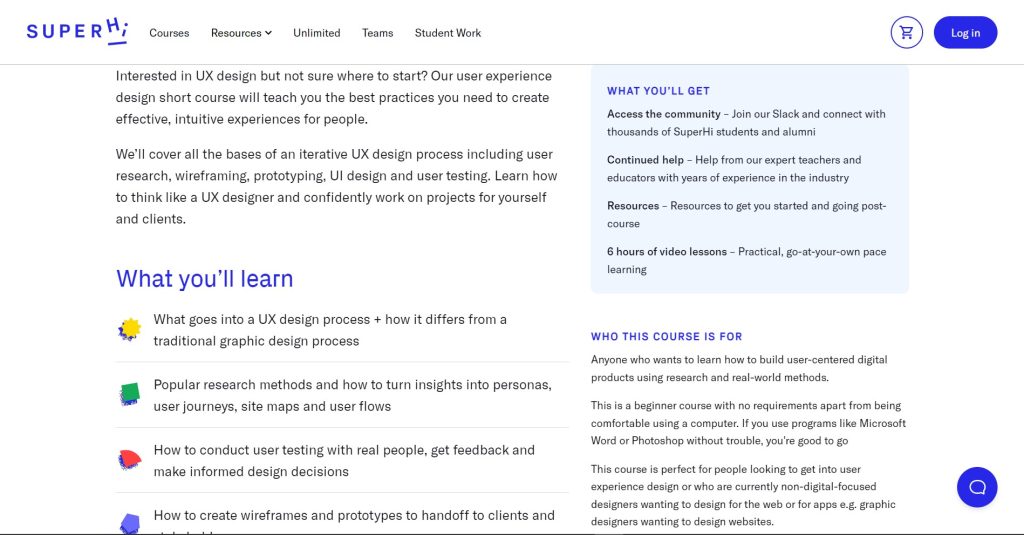
Key Features:
- Learn best practices for UX design process and methods
- Create wireframes and prototypes using Figma
- Conduct user testing and get feedback
Why You Should Consider:
Consider this course if you’re keen on diving into UX design from scratch, learning from experienced professionals, and gaining access to practical resources and a supportive community
Recommendations Recap
- Best Overall: DesignLab’s UX Academy
- Best Paid: Springboard UX Design Bootcamp
- Best Free: Google UX Design Professional Certificate on Coursera
- Best for Beginners: CareerFoundry’s UX Design Short Course
- Highest Rated: UX: The Ultimate Guide to Usability and UX (Udemy)
FAQs
Is a UX Design degree necessary?
A UX Design degree is unnecessary, but having a solid foundation in UX design principles and techniques is crucial. Many successful UX designers have gained their knowledge and skills through online courses, bootcamps, and self-learning.
Are there any prerequisites needed to take a UX Design course?
Most UX Design courses do not have specific prerequisites, but some prior knowledge of design principles and basic computer skills might be helpful. Each course will list any requirements or recommended background knowledge, if applicable.
Are UX Designers currently in demand?
Yes, UX Designers are in high demand as companies recognize the importance of providing a great user experience for their customers. The demand for UX Designers is expected to continue to grow in the coming years.
Can you learn UX Design in 3 months?
While gaining a foundational understanding of UX design principles and techniques in 3 months is possible, becoming proficient in UX design requires time, practice, and real-world experience. Many UX design courses and bootcamps offer programs that range from a few weeks to several months, allowing learners to develop their skills at their own pace. Remember that continued learning and staying up-to-date with industry trends and best practices is essential for a successful career in UX design.




